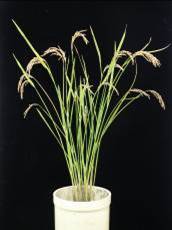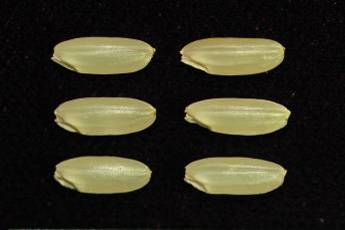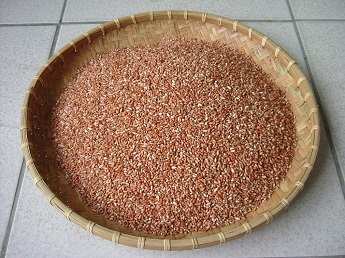
‧Plant appearance of high grain protein content variety Rice ‘Hualien No. 24’. 
‧Brown rice appearance of low grain protein content rice variety Rice ‘Hualien No. 25’. 
‧The brown rice of‘Hualien No. 22’ is bright red in color and produces a fresh fragrance when cooked. |
The objectives involving rice are to improve rice varieties and to facilitate the research and extension of cultivation technologies. Concerning the improvement of rice varieties, our goal is to breed high-quality, highyield, disease-and-pest-resistant rice varieties, as well as those for special purposes. To date, seven excellent rice varieties have been cultivated: ‘Taikeng No. 4, ‘Taikeng No. 6’, ‘Taikeng No. 10’, ‘Taikeng No. 16’, ‘Hualien No. 19’, ‘Hualien No. 20’, and ‘Hualien No. 21’. ‘Taikeng No. 4’ is an aromatic rice variety that features a fresh fragrance and a special flavor; ‘Taikeng No. 16’ features high yield, favorable taste, strong stalk, and is resistant to brown planthoppers. With 29,000 ha in annual cultivation area, ‘Taikeng No. 16’ once accounted for 9.6% of the national rice cultivation and became popular among farmers and consumers. ‘Hualien No. 21’ features characteristics such as low fertilizer demand, high resistance to brown planthopper, easy management, and favorable taste.
Regarding the breeding of diversified rice varieties in recent years, results include ‘Hualien No. 22’ (red aromatic glutinous rice), ‘Hualien No. 23’ (with beautiful purple
To enhance the quality of rice in this district, we are devoted to performing research that enables us to improve the appearance and eating quality of our Because the Hualien environment is free from industrial pollution, it is suitable for developing organic rice. Our station is dedicated to the research of management techniques used in the cultivation of organic rice.
The research of rice bran to be used as weed control for paddy fields. These measures effectively reduce weed hazards during the early stages of organic crop breeding, facilitate the development of an organic rice cultivation system, and enable the counseling of organic crop growing in the Hualien and Yilan regions. Organic rice cultivation areas in our jurisdiction have observed gradual growth over the years, and annual cultivation areas have now reached more than The aboriginal tribes in the Hualien region have abundant stocks of native rice germ resources. Therefore, we performed research on varietal purification and application using native rice breeds such as Kwan-Fu aromatic rice and upland rice that we have collected and preserved. In addition, we helped farmers improve rice cultivation management techniques to maximize the use of diverse rice varieties. |
|---|

